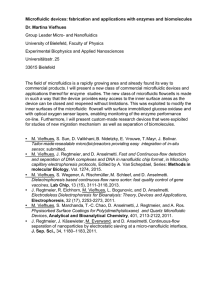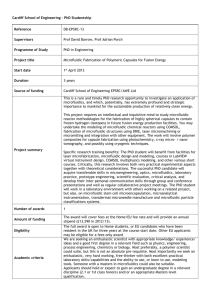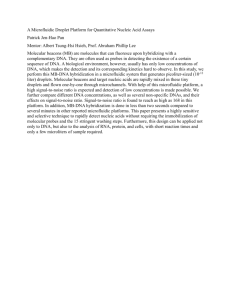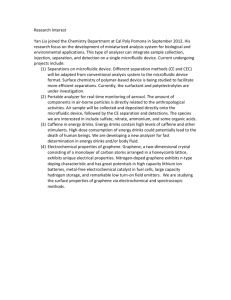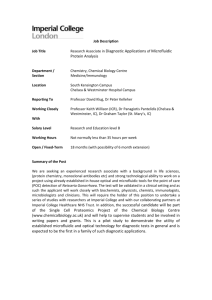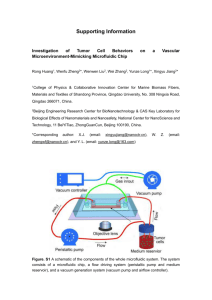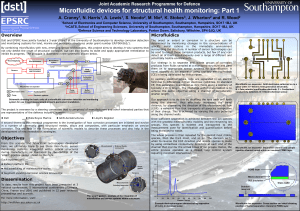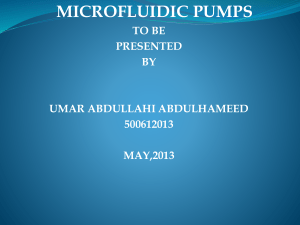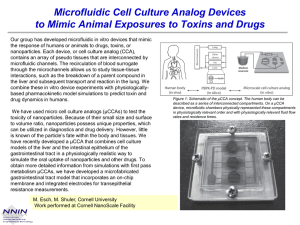Micro/Nano fluidic computing:
advertisement
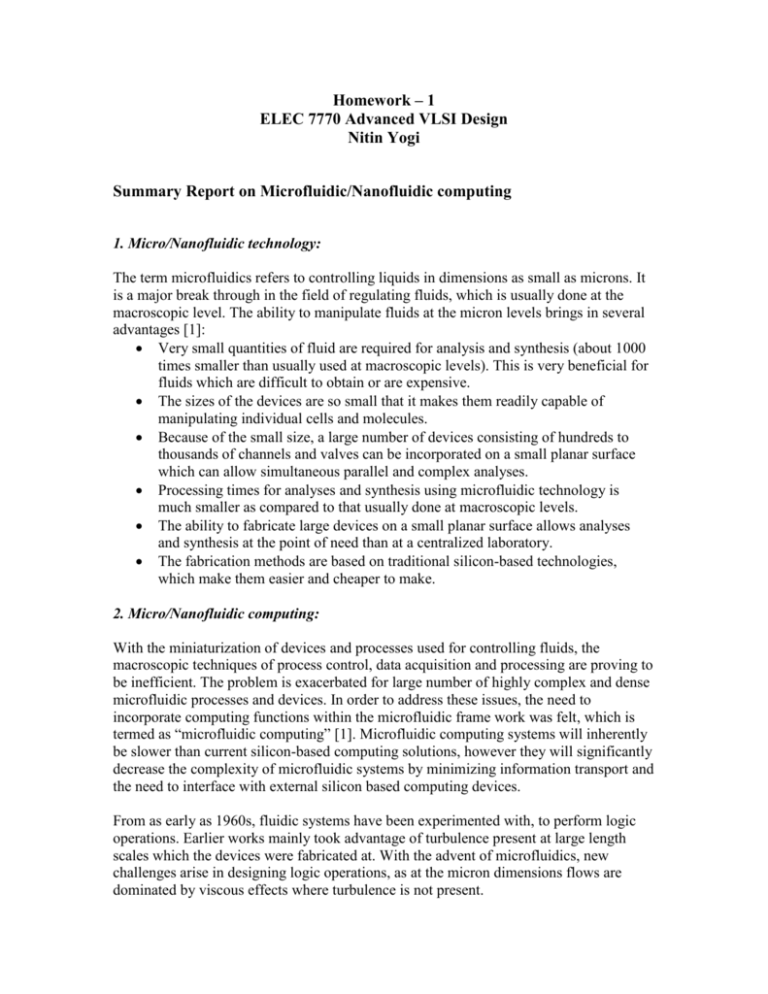
Homework – 1 ELEC 7770 Advanced VLSI Design Nitin Yogi Summary Report on Microfluidic/Nanofluidic computing 1. Micro/Nanofluidic technology: The term microfluidics refers to controlling liquids in dimensions as small as microns. It is a major break through in the field of regulating fluids, which is usually done at the macroscopic level. The ability to manipulate fluids at the micron levels brings in several advantages [1]: Very small quantities of fluid are required for analysis and synthesis (about 1000 times smaller than usually used at macroscopic levels). This is very beneficial for fluids which are difficult to obtain or are expensive. The sizes of the devices are so small that it makes them readily capable of manipulating individual cells and molecules. Because of the small size, a large number of devices consisting of hundreds to thousands of channels and valves can be incorporated on a small planar surface which can allow simultaneous parallel and complex analyses. Processing times for analyses and synthesis using microfluidic technology is much smaller as compared to that usually done at macroscopic levels. The ability to fabricate large devices on a small planar surface allows analyses and synthesis at the point of need than at a centralized laboratory. The fabrication methods are based on traditional silicon-based technologies, which make them easier and cheaper to make. 2. Micro/Nanofluidic computing: With the miniaturization of devices and processes used for controlling fluids, the macroscopic techniques of process control, data acquisition and processing are proving to be inefficient. The problem is exacerbated for large number of highly complex and dense microfluidic processes and devices. In order to address these issues, the need to incorporate computing functions within the microfluidic frame work was felt, which is termed as “microfluidic computing” [1]. Microfluidic computing systems will inherently be slower than current silicon-based computing solutions, however they will significantly decrease the complexity of microfluidic systems by minimizing information transport and the need to interface with external silicon based computing devices. From as early as 1960s, fluidic systems have been experimented with, to perform logic operations. Earlier works mainly took advantage of turbulence present at large length scales which the devices were fabricated at. With the advent of microfluidics, new challenges arise in designing logic operations, as at the micron dimensions flows are dominated by viscous effects where turbulence is not present. Several works have been reported in the field of microfluidic computing till date which is described below: 2.1 Logic gates by electrochemical reactions: Dr. Richard Crooks and his team at Texas A&M University have developed devices based on microfluidic electrochemical technology, which mimic solid-state devices like diode/ transistors and logic functions like OR/AND [2]. The basis of operation of these devices is a network of microfluidic electrochemical cells that communicate via conductive solutions. The microfluidic technology is used to replenish the reagents but not directly in performing logic operations. Figure 1 shows an example of a microelectrochemical device configuration that mimics diode and FET behavior. Figure 1: A microelectrochemical device configuration that mimics diode and FET behavior [2]. Figure 2: Illustration and realization of a microfluid-based NOT gate [2] 2.2 Logic gates by relative resistance: Vestad, Marr and Munakata implemented basic logic gates like NOT, AND, OR and NAND in microfluidic technology using the principle of relative resistance of fluid flows[3]. The approach is purely fluidic, requires no electronic control and hence is simplistic, inexpensive and versatile. One unique feature of this technique is that a number of gates can be fabricated on a single unit. As the functioning of such devices is based on fluid flows, the input to the devices is either allowing flow (logic ‘1’) or turning off flow (logic ‘0’). An insoluble dye is used as an output indicator; its presence at the output indicates logic ‘1’ and absence logic ‘0’. Figure 2 shows the illustration and realization of a microfluid-based NOT gate. The inlet flows are to the left and the outlet flows to the right. A constant bottom inlet flow of the dye fluid is maintained. As seen in the figure, when the upper inlet stream is off (logic ‘0’), the upper output stream is dyed (logic ‘1’). When the upper inlet stream is turned on (logic ‘1’), the upper output stream is clear (logic ‘0’). 2.3 Nanofluidic transistors: Dr. Majumdar and Dr. Yang from University of California, Berkeley have fabricated “nanofluidic transistors” which control the flow of ions through nanoscaled water-filled tubes [4][5]. Figure 3 shows a schematic diagram of the constructed nanofluidic transistor. Figure 3: Nanofluidic transistor [5] Figure 4: Fabricated nanofluidic transistor [5] The nanofluidic transistor consists of a 35 nm high channel constructed between two silicon dioxide plates. The channel is filled with water and potassium chloride salt. By applying a voltage across the channel by means of electrodes attached to the plates, the flow of potassium ions through water can be shut off. This is analogous to the control of electron flow through a transistor by means of a gate voltage. This transistor can then be further connected to an electronic chip to control fluidics. Figure 4 shows a picture of the fabricated nanofluidic transistor. These nanofluidic transistors can be built using the same traditional silicon-based technologies as being used in today’s integrated circuits. Having built the basic building block, the inventors envisage in the future the possibility of a microscopic chemical plant without any moving parts such as valves, pumps or mixers. 2.4 Nanofluidic memory: Stephen Quake and his team from Stanford University have developed microfluid-based control and memory elements through the use of viscoelastic polymer solutions [6]. The group has successfully fabricated a flux stabilizer and bistable flip-flop memory by taking advantage of non-linearity in the fluid viscocity. Figure 5 shows the fabricated flux stabilizer. It is a non-linear fluidic resistor in which the flux rate varies the applied pressure in a non-linear fashion. Figure 6 shows the implementation of a microfluidic flip-flop. The active element of the device is a crossroad (shown inset in figure 6) which consists of two flow inlets (horizontally placed) and two flow outlets (vertically placed). The difference in design of the two inlets causes a corresponding difference in the flow resistances of the polymer solution which establishes two distinct flow patterns as shown in figure 7. The left picture represents one of the states of the flip flop, showing the flow from the left inlet to the bottom outlet and from the right inlet to the upper outlet. The right picture represents the second state of the flip flop where the flow is from the left inlet to the upper outlet and right inlet to the bottom outlet. Figure 5: Fabricated flux stabilizer (non-linear resistor) [6] Figure 6: Microfluidic flip-flop [6] Figure 7: Two distinct flow patterns representing the states of the flip flop [6] 2.5 Bubble logic: Prakash and Gershenfeld from MIT have implemented logic gates like AND, OR and NOT using bubble logic in microfluidic channels [7]. The functioning of the devices is based on bubbles traveling in microchannels, which represent bits of information. Through the transportation of bubbles, the information transfer from the input to the output is maintained, which enables cascading of devices and construction of combinational and sequential Boolean logic. Figure 8 shows an example of a bubble logic gate which evaluates AND and OR operations simultaneously. Figure 9 shows its functioning. A bubble entering the junction either from input A or input B will go through the (A+B) path due to the lower resistance provided by the wider channel. In the case where one bubble enters from both A and B inputs, the first bubble entering passes through the (A+B) path increasing its output flow resistance, thus directing the bubble coming later to the A∙B path. Figure 8: Example of a bubble logic gate implementing AND and OR operations simultaneously [7] Figure 9: Operation of bubble logic gate shown in figure 8 [7] References: [1] D.W.M. Marr and T. Munakata, "Micro-/Nanofluidic Computing," Communications of the ACM, 50, 9, September 2007, pp. 64-68. [2] Zhan, W. and Crooks, R.M. Microelectrochemical logic circuits. J. Am. Chem. Soc. 125, (2003), 9934– 9935. [3] Vestad, T., Marr, D.W.M., and Munakata, T. Flow resistance for microfluidic logic operations. Applied Physics Letters 84, 25 (June 21, 2004), 5074–5075. [4] Karnik, R. et al. Electrostatic control of ions and molecules in nanofluidic transistors. Nano Letters 5, 5 (May 11, 2005), 943–948. [5] http://www.physorg.com/news4815.html [6] Groisman, A., Enzelberger, M., and Quake, S.R. Microfluidic memory and control devices. Science 300 (2003), 955–958. [7] Prakash, M. and Gershenfeld, N. Microfluidic bubble logic. Science 315 (2007), 832–835.
